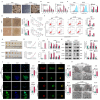E2F1-autophagy-ALDH1A1 axis enhances self-renewal and drug resistance of lung cancer stem-like cells in a p53-dependent manner
- PMID: 40886002
- PMCID: PMC12398038
- DOI: 10.1186/s13046-025-03506-4
E2F1-autophagy-ALDH1A1 axis enhances self-renewal and drug resistance of lung cancer stem-like cells in a p53-dependent manner
Abstract
Lung adenocarcinoma (LUAD) is a predominant subtype of non-small cell lung adenocarcinoma (NSCLC). It is typically asymptomatic and associated with high mortality rates. Despite recent advancements in screening technologies and therapeutic approaches, its pathogenesis still remains elusive. Therefore, it is imperative to explore new diagnostic markers and therapeutic targets for LUAD management. Cancer stem cells (CSCs) have high self-renewal capacity and incur therapeutic resistance, thus, considered as crucial elements in initiating and promoting tumor development. Contextual to this, the present study reveals the role of the transcriptional activator E2F1 in LUAD oncogenesis and its association with various biological characteristics of lung cancer stem cells (LCSCs). Whereby, it may also serve as a crucial factor in regulating autophagy. Autophagy can modulate stemness by either promoting or inhibiting CSCs characteristics. Pertinently, our study integrated bioinformatics, in-vitro and in-vivo experiments to elucidate that E2F1 can induce ALDH1A1 through autophagy, thus promoting self-renewal and drug resistance of LCSCs, as well as tumorigenicity. Mechanistically, "E2F1-autophagy-ALDH1A1" axis enhanced the self-renewal capacity and drug resistance of LCSCs in a p53-dependent manner, highlighting the potential of E2F1 as a promising marker for LUAD.
Keywords: Autophagy; Drug resistance; E2F1; Lung cancer stem cells; Self-renewal; p53.
© 2025. The Author(s).
Conflict of interest statement
Declarations. Ethics approval and consent to participate: All animal experiments were approved and licensed by the Animal Ethics Committee of Southwest Medical University (NO. 20211121-003). This study was approved by the Institutional Review Board of the Affiliated Hospital of Southwest Medical University (NO.KY2024460), and informed consent was waived due to the retrospective nature of the research. Consent for publication: All authors confirm their consent to publish this manuscript. Competing interests: The authors declare no competing interests.
Figures







References
-
- Sung H, Ferlay J, Siegel RL, Laversanne M, Soerjomataram I, Jemal A, et al. Global cancer statistics 2020: GLOBOCAN estimates of incidence and mortality worldwide for 36 cancers in 185 countries. CA Cancer J Clin. 2021;71(3):209–49. - PubMed
-
- Batlle E, Clevers H. Cancer stem cells revisited. Nat Med. 2017;23(10):1124–34. - PubMed
MeSH terms
Substances
Grants and funding
LinkOut - more resources
Full Text Sources
Medical
Research Materials
Miscellaneous

